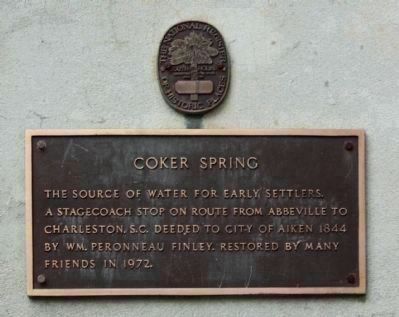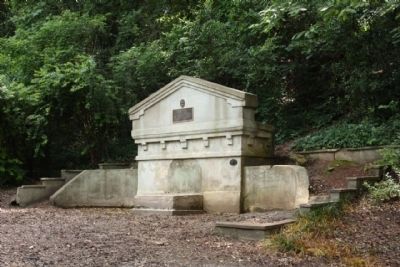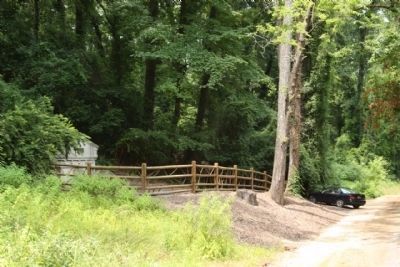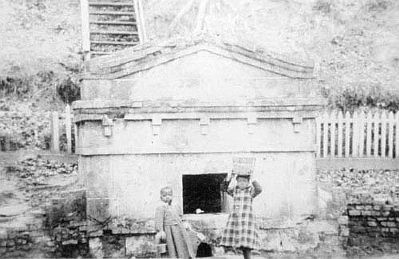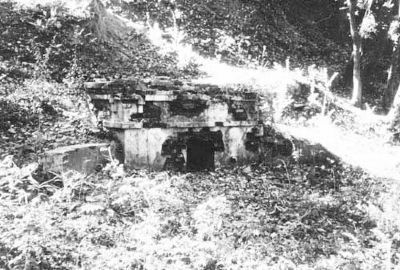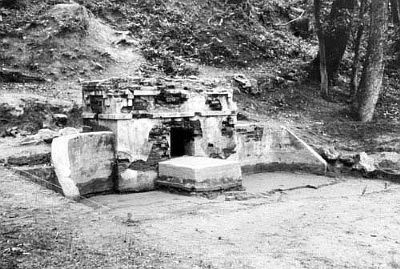Aiken in Aiken County, South Carolina — The American South (South Atlantic)
Coker Spring
Inscription.
The source of water for early settlers.
A stagecoach stop on route from Abbeville to
Charleston, S.C. Deeded to City of Aiken 1844
by Wm. Peronneau Finley. Restored by many
friends in 1972.
(Upper Medallion)
The National Register
of Historic Places
South Carolina
Department of Archives
And History
Coker Spring
Topics. This historical marker is listed in this topic list: Natural Features. A significant historical year for this entry is 1844.
Location. 33° 33.035′ N, 81° 43.641′ W. Marker is in Aiken, South Carolina, in Aiken County. Marker is on Coker Springs Road SW, on the left when traveling west. Turn on Coker Springs Road off of Whiskey Road. (Coker Springs is between Easy Street and DuPree Place). Continue on Coker Springs as road becomes dirt. The Springs are down on the left. To depart you may continue on Coker Springs and turn right at the end onto Newberry Street. Touch for map. Marker is in this post office area: Aiken SC 29801, United States of America. Touch for directions.
Other nearby markers. At least 8 other markers are within walking distance of this marker. Aiken County Courthouse Bell (approx. 0.3 miles away); Aiken County Museum (approx. 0.3 miles away); Transit Of Venus Observatory Structure, 1882 (approx. 0.3 miles away); "Banksia" (approx. 0.3 miles away); a different marker also named Banksia (approx. 0.3 miles away); Frederick Ergle Log Cabin (approx. 0.3 miles away); Water Trough and Drinking Fountain (approx. 0.3 miles away); The One Room Schoolhouse (approx. 0.4 miles away). Touch for a list and map of all markers in Aiken.
Regarding Coker Spring. Coker Spring is a fresh water spring. Archeological remains found near this property suggest that this was probably a water supply for prehistoric Indians. The spring later served as the source of drinking water for the early settlers of Aiken (ca. 1830-1890). The spring is covered by a springhouse, which is constructed of brick, covered with stucco. The front façade features a pedimented entranceway with a wide entablature. Stuccoed brick retaining walls extend along the left and right sides of the springhouse. The first recorded owner of Coker Spring was Ephraim Franklin who obtained the spring as part of a 285-acre land grant in 1787. Apparently the spring then changed hands several times. The spring gained prominence as a regular stop on the stagecoach route from Abbeville to Charleston, and also as the major source of drinking water for the town of Aiken which had been chartered in 1835. Eventually, however, the spring fell into ruin. Listed in the National Register January 18, 1978.(South Carolina Department of Archives and History)
National Register of Historic Places:
Coker Spring (added 1978 - - #78002490)
Coker Spring Rd. , Aiken
♦ Historic Significance: Information Potential, Event
♦ Area of Significance: Historic - Aboriginal, Social History
♦ Cultural Affiliation: None Listed
♦ Period of Significance: 1950-1974, 1875-1899, 1825-1849, 1800-1824, 1750-1799, 1000-500 AD
♦ Owner: Local
♦ Historic Function: Domestic, Landscape
♦ Historic Sub-function: Conservation Area, Park, Secondary Structure
♦ Current Function: Landscape
Also see . . . The Legacy of Coker Spring, from Aiken Regional Medical Centers. ...a fresh water spring that is formed by a "junction" where the water table intersects the ground surface. Archeologists have discovered evidence that in prehistoric times, Coker Spring served the first Native American people who lived around the area that eventually came to be called "Aiken." As fresh water sites have always been, this spring was most certainly a place where people and animals stopped for refreshment over many millennia. (Submitted on June 26, 2012, by Mike Stroud of Bluffton, South Carolina.)
Additional commentary.
1. Coker Spring
By 1791, Ephraim Franklin received
a land grant for a 285-acre farm which included the site of Coker Spring. Coker Spring was a
major source of water for the town of Aiken through the eighteenth and nineteenth centuries.
——
William Peronneau Finley was President of Charleston College 1857. Member S. C. Seccession Congress. Elder Presbyterian Church.
— Submitted June 26, 2012, by Mike Stroud of Bluffton, South Carolina.
2. Coker Spring
there was a girls' school, which was run by a French woman named Madame Bonnetheau, near Coker Spring around the time of the Civil War. The school prompted young men to loiter around the spring, so they could catch a glimpse of or walk with the girls.
—
In 1876, federal troops who were called to maintain law and order during the Reconstruction era camped near Coker Spring.
—
When Aiken City Council established a central waterworks in 1892, artesian wells replaced Coker Spring as the city's main water source
(The Augusta Chronicle)
— Submitted June 27, 2012, by Mike Stroud of Bluffton, South Carolina.
Credits. This page was last revised on June 16, 2016. It was originally submitted on June 26, 2012, by Mike Stroud of Bluffton, South Carolina. This page has been viewed 1,882 times since then and 252 times this year. Photos: 1, 2, 3. submitted on June 27, 2012, by Mike Stroud of Bluffton, South Carolina. 4, 5, 6. submitted on June 26, 2012, by Mike Stroud of Bluffton, South Carolina.
